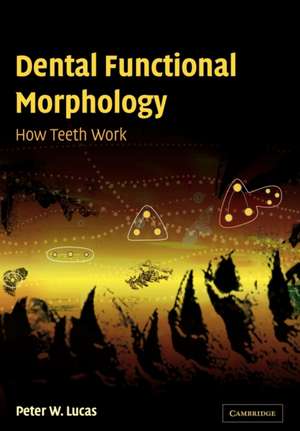Dental Functional Morphology: How Teeth Work
Autor Peter W. Lucasen Limba Engleză Paperback – 28 ian 2007
| Toate formatele și edițiile | Preț | Express |
|---|---|---|
| Paperback (1) | 444.17 lei 6-8 săpt. | |
| Cambridge University Press – 28 ian 2007 | 444.17 lei 6-8 săpt. | |
| Hardback (1) | 901.62 lei 6-8 săpt. | |
| Cambridge University Press – 2 iun 2004 | 901.62 lei 6-8 săpt. |
Preț: 444.17 lei
Nou
Puncte Express: 666
Preț estimativ în valută:
85.00€ • 88.42$ • 70.17£
85.00€ • 88.42$ • 70.17£
Carte tipărită la comandă
Livrare economică 14-28 aprilie
Preluare comenzi: 021 569.72.76
Specificații
ISBN-13: 9780521035408
ISBN-10: 0521035406
Pagini: 372
Ilustrații: 104 b/w illus. 25 tables
Dimensiuni: 170 x 244 x 20 mm
Greutate: 0.59 kg
Editura: Cambridge University Press
Colecția Cambridge University Press
Locul publicării:Cambridge, United Kingdom
ISBN-10: 0521035406
Pagini: 372
Ilustrații: 104 b/w illus. 25 tables
Dimensiuni: 170 x 244 x 20 mm
Greutate: 0.59 kg
Editura: Cambridge University Press
Colecția Cambridge University Press
Locul publicării:Cambridge, United Kingdom
Cuprins
Preface; Flickart; 1. How to get excited about teeth; 2. The basic structure of the mammalian mouth; 3. How the mouth operates; 4. Tooth shape; 5. Tooth size; 6. Tooth wear; 7. The evolution of the mammalian dentition; Appendix A. Mechanical properties and their measurement: material properties made easy; Appendix B. Properties of teeth and potential foods; Notes; References; Index.
Recenzii
'… provides a fresh perspective on dental function … readers interested in such topics as evolution, diet and ecology will enjoy his many other ideas about how vertebrate teeth work … Lucas succeeds in conveying his enthusiasm for the challenges of learning about the biology and ecology of organisms from such a small and humble organ. Although the book contains plenty of mechanics, the equations are presented clearly and well explained. Lucas has filled the text with fascinating observations, humorous asides and wonderfully detailed footnotes.' Nature
'… a very well written text and covers a great deal of ground … The author's style is very chatty and his sense of humour pervades the whole text making the book very readable.' British Dental Journal
'… this is a great book, and I strongly recommend it to anyone interested in dental functional morphology.' American Journal of Physical Anthropology
'The book's strength lies in its focus on the application of engineering principles to questions of dental functional morphology … Dental Functional Morphology presents an original and comprehensive overview of its field, and it provides a rich source of fresh ideas, including testable hypotheses. The mechanical engineering approach outlined in the book will certainly lead to new studies and insights into the functional significance of the diverse morphologies of vertebrate teeth.' Science
'… there is no other up-to-date single-authored book on the subject of dental functional morphology, so in this right this book is valuable. Lucas delivers a text worthy of use as a textbook and a primary source that will last for years to come. … It is clear, easy to read, with concepts explained in a sensible, logical manner that should appeal to students and researchers. His sparing use of jargon makes this an uncommonly accessible book; something that I anticipate will make this internationally cited and read. … I have rarely read such a book that has inspired me to add so much marginalia of future research ideas! If your work has any involvement of the function of dentitions or oral anatomy, you need to read this book.' www.PalArch.nl
'… a very well written text and covers a great deal of ground … The author's style is very chatty and his sense of humour pervades the whole text making the book very readable.' British Dental Journal
'… this is a great book, and I strongly recommend it to anyone interested in dental functional morphology.' American Journal of Physical Anthropology
'The book's strength lies in its focus on the application of engineering principles to questions of dental functional morphology … Dental Functional Morphology presents an original and comprehensive overview of its field, and it provides a rich source of fresh ideas, including testable hypotheses. The mechanical engineering approach outlined in the book will certainly lead to new studies and insights into the functional significance of the diverse morphologies of vertebrate teeth.' Science
'… there is no other up-to-date single-authored book on the subject of dental functional morphology, so in this right this book is valuable. Lucas delivers a text worthy of use as a textbook and a primary source that will last for years to come. … It is clear, easy to read, with concepts explained in a sensible, logical manner that should appeal to students and researchers. His sparing use of jargon makes this an uncommonly accessible book; something that I anticipate will make this internationally cited and read. … I have rarely read such a book that has inspired me to add so much marginalia of future research ideas! If your work has any involvement of the function of dentitions or oral anatomy, you need to read this book.' www.PalArch.nl
Descriere
Innovative theory showing how mammalian tooth form can be understood using considerations of food fracture.













